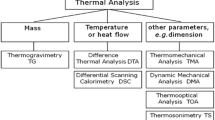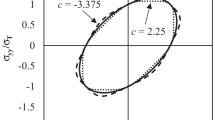Abstract
A new approach to ultrasonic measurement of stress was proposed recently by Man and Lu. That approach is based on universal relations that result from material symmetry in an acoustoelastic theory applicable to plastically deformed bodies for which superimposed ultrasonic waves can be taken as elastic. When applicable, the Man-Lu approach circumvents the two main difficulties of the acoustic-birefringence method, namely those of unknown initial texture and plastic deformation. An experiment was performed to verify a new universal relation derived by Man and Lu in their earlier work. Plastic strain was developed during the test. The results were in basic accord with the prediction of the theory.
Similar content being viewed by others
References
Pao, Y.-H., Sachse, W. and Fukuoka, H., “Acoustoelasticity and Ultrasonic Measurements of Residual Stresses,” Physical Acoustics,XVII,ed. W.P. Mason and R.N. Thurston, Academic Press, 61–143 (1984).
Johnson, G.C., “Acoustoelastic Theory for Elastic-plastic Materials,”J. Acoust. Soc. Am. 70 591–595 (1981).
Johnson, G.C., “The Effect of Plastic Deformation on the Acoustoelastic Response of Metals,”J. Appl. Mech.,50,689–691 (1983).
Pao, Y.-H. and Gamer, U., “A Theory of Acoustoelasticity for Elasto-Plastic Solids,” Rep. No. 5121 of Materials Science Center, Cornell Univ. (1983).
Lu, W.Y., “Residual Stress Evaluation by Ultrasonics in an Elasticplastic Material,” Proc. SEM Spring Conf. on Exp. Mech., 77–83 (1983).
Johnson, G.C., “On the Applicability of Acoustoelasticity for Residual Stress Determination,”J. Appl. Mech.,48,791–795 (1981).
Clark, A.V., Moulder, J.C., Trevisan, R.E., Siewert, T.A. and Mignogna, R.B., “Ultrasonic Techniques for Residual Stress Measurement in Thin Welded Aluminum Plates,” Review of Progress in Quantitative Nondestructive Evaluation,5B,ed. D.O. Thompson and D.E. Chimenti, Plenum, 1461–1472 (1985).
Rollins, F.R., “Ultrasonic Methods for Nondestructive Measurement of Residual Stress,” WADD Tech. Rep. 61-42, Part I (1961). Reproduced by National Technical Information Service.
Rollins, F.R., Korbett, D.R. and Jones, J.L., “Ultrasonic Methods for Nondestructive Measurement of Residual Stress,” WADD Tech. Rep. 61-42, Part II (1962). Reproduced by National Technical Information Service.
Crecraft, D.I., “The Measurement of Applied and Residual Stresses in Metals Using Ultrasonic Waves,”J. Sound Vib.,5,173–192 (1967).
Crecraft, D.I., “Ultrasonic Measurement of Stress,” Ultrasonic Testing, ed. J. Szilard, John Wiley, 437–458 (1982).
Clark, A.V., Moulder, J.C., Mignogna, R.B. and DelSanto, P.P., “A Comparison of Several Ultrasonic Techniques for Absolute Stress Determination in the Presence of Texture,” Solid Mechanics Research for Quantitative Non-destructive Evaluation, ed. J.D. Achenbach and Y. Rajapakse, Martinus Nijhoff Publishers, 345–360 (1987).
Man, C.-S. andLu, W.Y., “Towards an Acoustoelastic Theory for Measurement of Residual Stress,”J. Elasticity,17,159–182 (1987).
Thompson, R.B., Lee, S.S. andSmith, J.F., “Angular Dependence of Ultrasonic Wave Propagation in a Stressed, Orthorhombic Coninuum: Theory and Application to the Measurement of Stress and Texture,”J. Acoust. Soc. Amer.,80,921–931 (1986).
Thompson, R.B., Smith, J.F. andLee, S.S., “Microstructure-independent Acoustoelastic Measurement of Stress,”Appl. Phys. Lett.,44,296–298 (1984).
Thompson, R.B, Lee, S.S. and Smith, J.F., “Absolute Measurement of Stress in Textured Plates from Angular Dependence of the SH o Mode Velocity,” Review of Progress in Quantitative Nondestructive Evaluation,3B,ed. D.O. Thompson and D.E. Chimenti, Plenum, 1311–1319 (1984).
King, R.B. andFortunko, C.M., “Determination of In-plane Residual Stress States in Plates Using Horizontally Polarized Shear—Waves,”J. Appl. Phys.,54,3027–3035 (1983).
Biot, M.A., Mechanics of Incremental Deformations, John Wiley (1965).
Biot, M.A., “The Influence of Initial Stress on Elastic Waves,”J. Appl. Phys.,11,522–530 (1940).
Campbell, J.D. andDowling, A.R. “The Behavior of Materials Subjected to Dynamic Incremental Shear Loading,”J. Mech. Phys. Solids,18,43–63 (1970).
Cauchy, A.-L., “Sur l'equilibre et le mouvement intérieur des corps considérés comme des masses continues,”Ex. de Math.,4,293–319 (1829);reprinted, Oeuvres Complètes d'Augustin Cauchy,II,t. IX, Gauthier-Villars, Paris, 342–369 (1891).
Hsu, N.N., “Acoustical Birefringence and the Use of Ultrasonic Waves for Experimental Stress Analysis,”Experimental Mechanics,14,169–176 (1974).
Lu, W.Y., “A Personal Computer Based Testing System,” Proc. V Int. Cong. on Exp. Mech., SEM, 245–249 (1984).
Hirao, M. andPao, Y.-H., “Dependence of Acoustoelastic Birefringence on Plastic Strains in a Beam,”J. Acoust. Soc. Amer.,77,1659–1664 (1985).
Author information
Authors and Affiliations
Rights and permissions
About this article
Cite this article
Lu, W.Y., Man, C.S. Measurement of stress based upon universal relations in acoustoelasticity. Experimental Mechanics 29, 109–114 (1989). https://doi.org/10.1007/BF02321361
Received:
Revised:
Issue Date:
DOI: https://doi.org/10.1007/BF02321361




